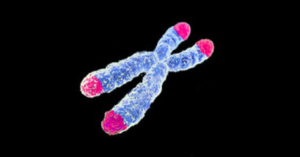Going beyond the known limits of our biology to extend life to extremes that are as yet unattainable is a dream that may be as old as humanity, but for the first time we have the right tools today to make it a reality in the near future. Genes and Longevity. The Challenges of Science (a publication by French national daily newspaper Le Monde). Page 11. 2018, translation.
Theme of the month. The limits of cellular divisions – cause or effect of aging?
At the ends of our chromosomes, there is a « non-coding » p art, which has no known direct use, namely telomeres. With each normal cell division, part of this telomere disappears. When the number of divisions has been large, the entire non-coding area disappears and the cell can no longer divide properly. The limit of the number of divisions (about 50 for an ordinary human cell) is called the Hayflick Limit, after a biogerontologist who discovered this mechanism in 1965.
art, which has no known direct use, namely telomeres. With each normal cell division, part of this telomere disappears. When the number of divisions has been large, the entire non-coding area disappears and the cell can no longer divide properly. The limit of the number of divisions (about 50 for an ordinary human cell) is called the Hayflick Limit, after a biogerontologist who discovered this mechanism in 1965.
This limit does not apply to all cells. Stem cells escape from it, but so also, unfortunately, do cancerous cells. So it is that the cells of Henrietta Lacks who died in 1951 of a sudden cancer are used in thousands of laboratories and still reproduce, almost 70 years after her death, without limitation.
Many people have taken the limit to cell division as being the major cause of aging. When the cells can no longer reproduce properly, the whole body gradually degrades, inevitably. Moreover, Leonard Hayflick, when he tested the limit of cellular divisions, realized that the cells of older people were dividing less often.
Those animals with telomeres that last longer, have a longer life span (for example in the case of dogs or birds). In the same way, there is a correlation between telomere length and human life expectancy.
In the context of this explanation of aging, there is some good news. The length of telomeres can be influenced in various ways. For example telomerase is an enzyme that, during cell division, allows for maintaining the length of the chromosome by adding a specific structure at each end. Some companies sell products containing telomerase which are supposed to promote a longer life.
The most famous person among the experimenters in the field of longevity, Liz Parrish carried out a gene therapy in 2015. The human telomerase gene (hTERT), which regulates the activity of the telomerase enzyme upward, was injected in several places to facilitate its spread throughout the body. Liz Parrish states that the length of her telomeres has increased considerably, which would establish a biological rejuvenation, for this aspect, of more than twenty years.
Unfortunately, the mechanisms of aging are a complex phenomenon. A famous scientific article entitled « The Hallmarks of Aging » considers that there are nine main causes of aging. Aubrey de Grey of SENS Research Foundation has seven of them. In both theories, the question of the length of telomeres concerns only part of these causes. It is therefore very unlikely that telomere elongation has a fundamental effect on longevity.
But even a positive effect only allowing us to gain « a few » years of life is rather uncertain. In this respect, telomere length is much like many aspects related to aging. The direction of causality is uncertain. For example, hair discoloration and wrinkles are consequences and not causes of age-related impairment. Finding a way to maintain the length of the telomeres could, therefore, have no significant impact on other aspects of senescence.
In addition, one of the main aspects of aging is neurological degradation (Alzheimer’s disease in particular). And yet neurons divide very little or not at all
Finally, for some supporters of the theories of the seven or nine origins of senescence these causes form an interdependent whole and attacking one or the other cause without attacking the others will have no real effect. Much as a car cannot function if only one element does not work (a car does not run without petrol, or without tires, or without a transmission…), a human body can only function long-term if a solution is found for all of the causes.
It is certain that many, if not all, aspects of senescence are closely linked. It is also certain that, as far as maximum lifespan is concerned, we have not made any further progress in recent years despite all the medical progress. It is therefore almost certain that future research will be multidisciplinary and complex. It will, therefore, be exciting from an intellectual and scientific point of view, in addition to its immense potential usefulness.
The good news of the month: another longevity fund.
A new fund for investing in companies working in the aging field was recently launched, the Longevity Vision Fund, a $100 million fund. According to Fight Aging, from what was said and presented at the Longevity Leaders conference in London on February 4, 2019, it seems that the directors of the Longevity Vision Fund want to follow in Juvenescence’s footsteps, initially focusing on the discovery of small pharmaceutical molecules.
For more information :
heales.org, sens.org, longevityalliance.org and longecity.org
photo: a chromosome and its telomeres
